Watch Writing

Watch Writing
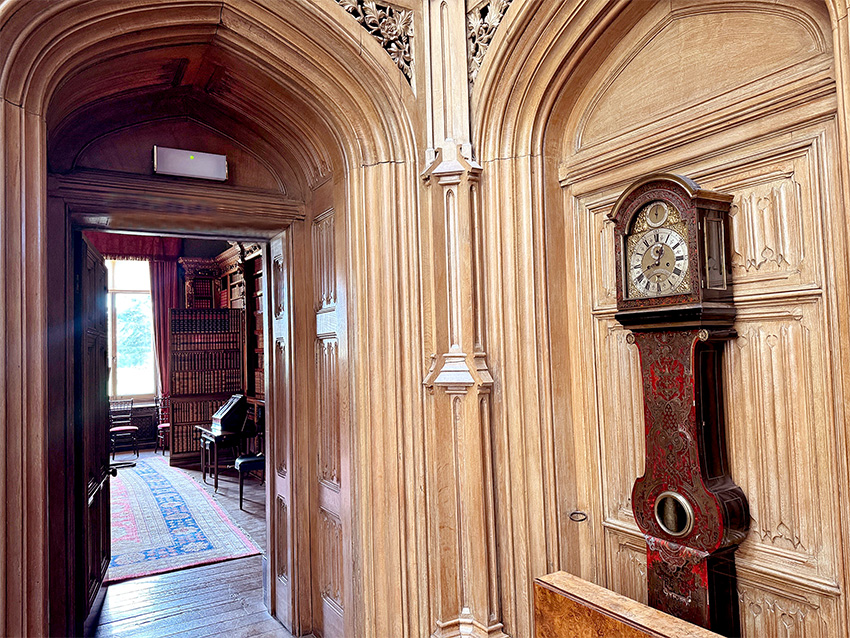 Wander into the Saloon, past the fireplace and around the armchairs towards the door into the main Library. Tucked into the alcove, just before the door, is a longcase clock with Venetian red painted decoration on the body of the clock where the pendulums and weights are housed.
Wander into the Saloon, past the fireplace and around the armchairs towards the door into the main Library. Tucked into the alcove, just before the door, is a longcase clock with Venetian red painted decoration on the body of the clock where the pendulums and weights are housed.
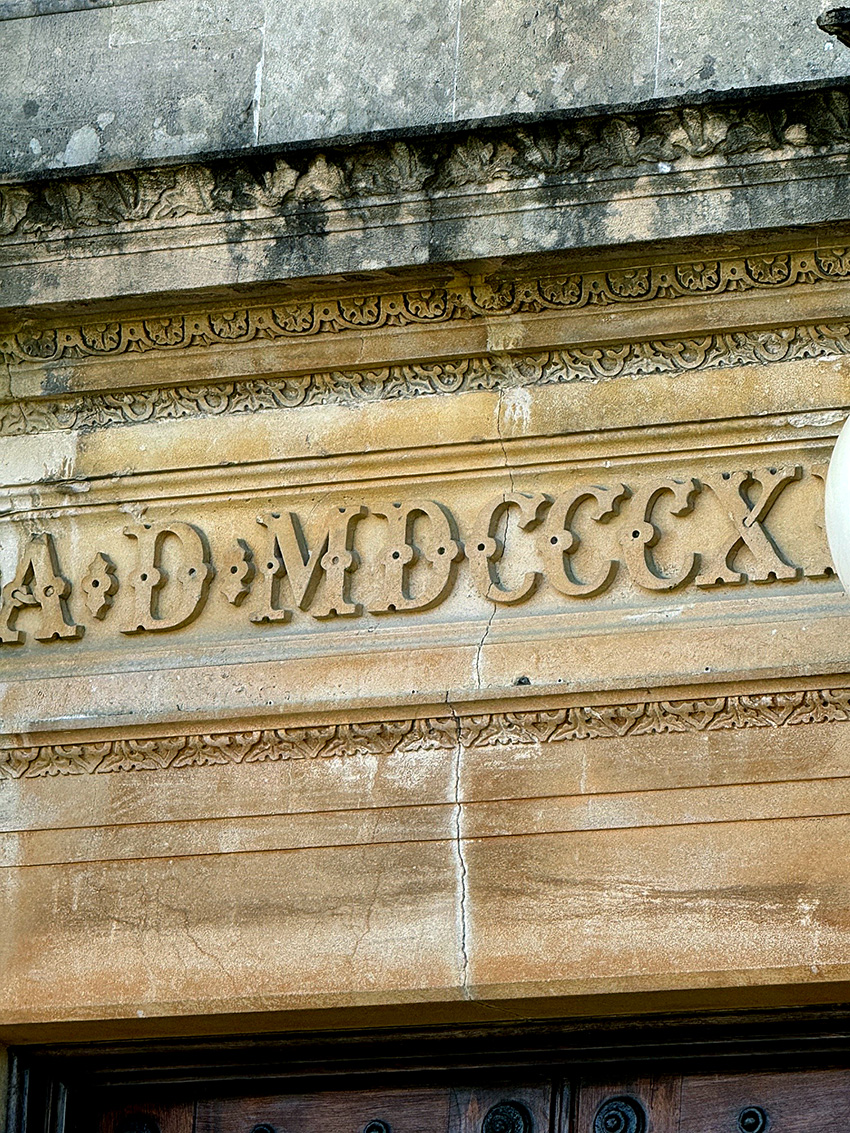 The face of the clock is in Roman numerals. Like many of you, I and my sisters were taught how to read these at school and it makes a fun game, almost like codebreaking. These numerals are now really only used for recording monumental dates but roman numerals are still understood in many different countries whatever their language and are part of the legacy of a communal language left to us by the Romans.
We all still use it - in the names of monarchs and popes, for example the late Elizabeth II or Pope Benedikt XVI or, in the USA, for sharing the same name across generations: John D. Rockefeller III.
The face of the clock is in Roman numerals. Like many of you, I and my sisters were taught how to read these at school and it makes a fun game, almost like codebreaking. These numerals are now really only used for recording monumental dates but roman numerals are still understood in many different countries whatever their language and are part of the legacy of a communal language left to us by the Romans.
We all still use it - in the names of monarchs and popes, for example the late Elizabeth II or Pope Benedikt XVI or, in the USA, for sharing the same name across generations: John D. Rockefeller III.
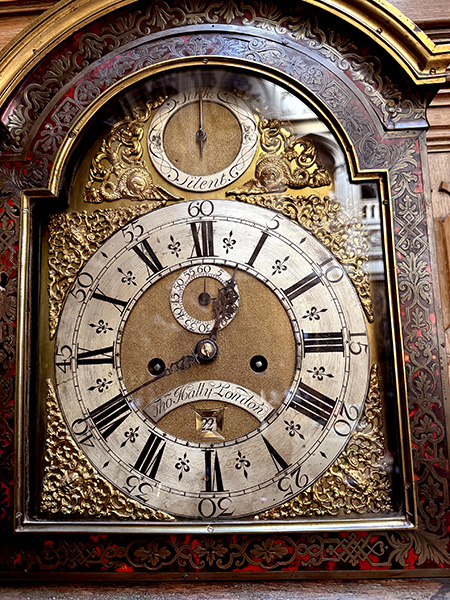 You may remember a ‘V’ is 5, ‘X’ 10 and you could use a ‘I’ to add or subtract to create the number or read the number. Of course, there is then an ‘L’ for 50, ‘C’ for 100, ‘D’for 500 and ‘M’ for 1000.
2024 = MMXXIV
1842= MIIXX XLII
1066 = M + LX + VI = MLXVI
Ironically however, there has never been an official nor universally accepted standard for roman numerals. Usage varied greatly in ancient Rome and even more so in medieval times. Maybe flexibility was one of its virtues though. One accepted way to notate 4 is IV but I have a watch with Roman numerals and 4 is written IIII. All the clocks at Highclere also seem to be written like this - they tend to be quite early clocks. However, a later, more famous clock, Big Ben, uses the more conventional IV for 4 o’clock.
You may remember a ‘V’ is 5, ‘X’ 10 and you could use a ‘I’ to add or subtract to create the number or read the number. Of course, there is then an ‘L’ for 50, ‘C’ for 100, ‘D’for 500 and ‘M’ for 1000.
2024 = MMXXIV
1842= MIIXX XLII
1066 = M + LX + VI = MLXVI
Ironically however, there has never been an official nor universally accepted standard for roman numerals. Usage varied greatly in ancient Rome and even more so in medieval times. Maybe flexibility was one of its virtues though. One accepted way to notate 4 is IV but I have a watch with Roman numerals and 4 is written IIII. All the clocks at Highclere also seem to be written like this - they tend to be quite early clocks. However, a later, more famous clock, Big Ben, uses the more conventional IV for 4 o’clock.
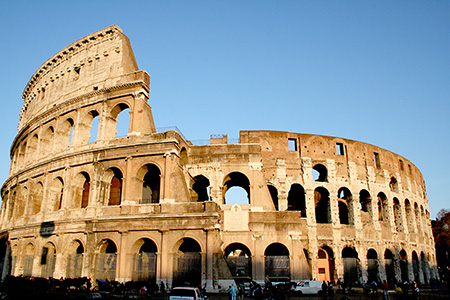 Even the Romans were not consistent. XIIX is used for the 18th day given that the Latin word for 18 is duodeviginti, transaltion “two from twenty” but is was also, quite literally, written in stone as XVIII. The Colosseum in Rome, built between 72-80AD, had numbered entrances for spectators some of which - XXIII (23) to LIII(54) - survive.
Roman numerals were derived from Etruscan number symbols, for example ⟨⟩, ⟨⟩, ⟨⟩, ⟨⟩, for 1, 5, 10, 50… but neither had a notation for the number zero. The word nulla was often employed instead and later the letter N was used to represent 0 as can be seen in Bede’s writings dating from c. 725AD.
Even the Romans were not consistent. XIIX is used for the 18th day given that the Latin word for 18 is duodeviginti, transaltion “two from twenty” but is was also, quite literally, written in stone as XVIII. The Colosseum in Rome, built between 72-80AD, had numbered entrances for spectators some of which - XXIII (23) to LIII(54) - survive.
Roman numerals were derived from Etruscan number symbols, for example ⟨⟩, ⟨⟩, ⟨⟩, ⟨⟩, for 1, 5, 10, 50… but neither had a notation for the number zero. The word nulla was often employed instead and later the letter N was used to represent 0 as can be seen in Bede’s writings dating from c. 725AD.
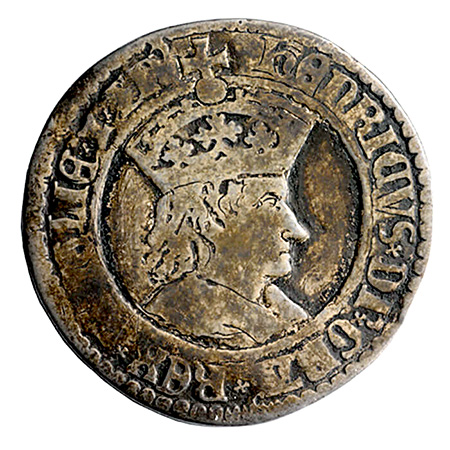 In order to record fractions, the Romans used the letter S which indicated 1/s and a duodecimal system which divided by 12. This was used in English currency for centuries in terms of pounds, shilling and pence. There were 12 pence in a shilling and 20 shillings in a pound. Shillings had a royal head embossed on them and were originally called testoon from ‘testa’ for head.
Today, the most common number system uses ten Arabic numerals - 0,1,2,3,4,5,6,7,8 and 9 - which does include a 0 symbol. This system was first mentioned in Europe in the 976 Codex Vigilanus but in turn was itself derived from an earlier Indian system. It is much easier to use for quicker and more complex mathematics but ironic that it was in Italy that it was first promoted - back to the Romans.
In order to record fractions, the Romans used the letter S which indicated 1/s and a duodecimal system which divided by 12. This was used in English currency for centuries in terms of pounds, shilling and pence. There were 12 pence in a shilling and 20 shillings in a pound. Shillings had a royal head embossed on them and were originally called testoon from ‘testa’ for head.
Today, the most common number system uses ten Arabic numerals - 0,1,2,3,4,5,6,7,8 and 9 - which does include a 0 symbol. This system was first mentioned in Europe in the 976 Codex Vigilanus but in turn was itself derived from an earlier Indian system. It is much easier to use for quicker and more complex mathematics but ironic that it was in Italy that it was first promoted - back to the Romans.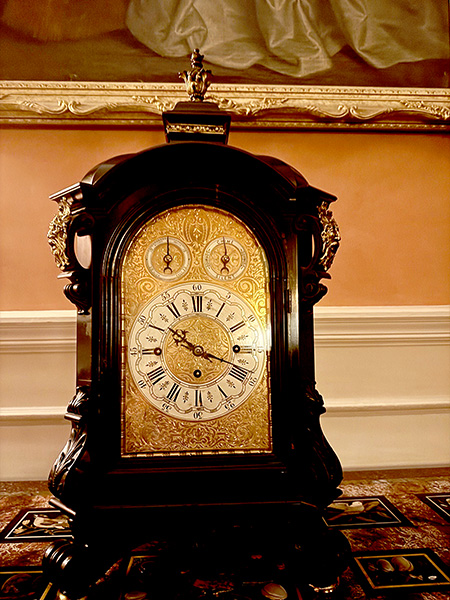 After all - what did the Romans do for us?
“Tempus omnia revelat” (Time reveals everything)
After all - what did the Romans do for us?
“Tempus omnia revelat” (Time reveals everything)
33 Comments
Lady Carnarvon,
Roman counting was a fun but exasperating exercise in IIIrd grade.
Thank you for reminding us!
Martha
Lovely the pictures of watch writing and did you and lord Carnarvon have a nice weekend and lam fan of Downton Abbey and highcelere castle
Thank you for today's writing - and for bringing something to our attention. I'm going to go looking for Roman Numerals on buildings now. I expect to find them in places I have previously looked but have never seen!
It is quite fun!
Enlightening as always! Thank you Lady Carnarvon for always sharing interesting bits of history from the lens of Highclere.
Dear Lady Carnarvon your 1842 looks a little bit unusual:):) it's a test, isn't it?
Kindest regards Petra Suchy
Thank you, Lady Carnarvon, for this enjoyable blog. Roman Numerals are so elegant and add style to any writing, especially in old-style script.
Kind regards.
They add gravitas
Great story and it is always GOOD to recharge one's brain.....loved your reminders !!! Thank You
Thank you. Really useful to understand Roman numerals if just for working out the dates on BBC tv programmes.
Happy Belated Birthday from America. Sincerely hope you had a wonderful day
Thank you so much
Fascinating! I remember Roman numerals from my youth (another thing, like cursive writing, that may be abandoned but fondly remembered and still used by some). I might've written 1842 as MDCCC XLII... it's interesting that you can choose different methods to arrive at the same numbers. I appreciate your thoughtful musings on the past (and those clocks are lovely).
Good day, Lady Carnarvon!
I LOVED learning and teaching Roman numerals! My students would always enjoy learning the historical meanings of Roman numerals, why the system was invented and then going into our present-day world and finding where they are appear. At the end of every film used in our studies we would look for the Roman numerals giving the year of production. What a treat to discover!
Thank you for highlighting Roman numerals and their daily significance at Highclere Castle.
Best wishes,
Donald Reinecker
Arlington, Virginia
That sounds wonderful
Another interesting read love my Monday reads always so very informative ,happy memories of my visit x
Another interesting, beautiful and factual Monday Morning Blog, thank you Lady Carnarvon.
Roman Numerals are very historic and impressive still useful at times these days. as here in the USA the NFL uses them to age their annual Super Bowl Football Game. The next one is Super Bowl LIX.
Thank you again for your Blog and Happy Belated Birthday to you!
You are very kind!
INTERESTING READ THANK YOU.
Dear lady Carnarvon your pieces of writing make my soul grow. Starting my Mondays by reading your blogs is one of my little joys in life. Have a nice week. Regards from Argentina.
I so enjoy reading your columns. I feel that I’m right there with you. Have a pleasant afternoon.
Happy Birthday,
Lady Carnarvon.
I enjoyed your piece on Roman Numerals as I used to teach Latin to elementary students. I am currently reading Lady Amina and the Real Downton Abbey. I am loving this history. It is a very interesting and wonderful book!
I loved writing it -
Belated Birthday wishes. I’m glad you had a relaxing day, hopefully a celebratory one too.
Thank you for another most interesting blog. I didn’t know much about the history of Roman numerals, so I was pleased to learn something more.
Thank you
Happy Birthday Lady Carnevon all the best and many Greetings from Germany.
Danke sehr !
Loved this writing. It also reminds me to be sure to teach my granddaughter Roman numerals. The photos of the clocks with the IIII are wonderful. I'll begin to keep my eyes open for others as I travel through this life. Thank you for your wonderful writing, it is such a joy to read.
The clocks are rather wonderful and my wrist watch still has Roman numerals..
Thank you so much, Lady Carnarvon. I enjoyed learning these in school as well. Unfortunately, like cursive writing, this is no longer taught. Thank you also for giving the various formats in history and for the lovely illustrations.
It is a bit of a mistake to pass by learning to write -
Two years of required Latin study in high school gave me lifelong knowledge of Roman numbers. At the time, more years ago than I care to remember, I never would have guessed how often that has come in handy!
Absolutely fascinating. Thank you for your research and for sharing this information.
Warm regards,
Jane McIntosh
British Columbia, Canada
Look forward to getting the email that has your blog. You always have such interesting subjects. Thanks for sharing. I was fortunate enough to be able to visit your lovely home summer of 2023. Thanks for sharing your home.
These homes come to life with people..
Mi felicitación desde el país Vasco en España lady Carnarvon.
Muy apasionantes sus historias y todo lo relacionado con su pais ,soy una enamorada de su país
Espero algún día poder visitar su castillo,me encanta
Saludos
Thank you
Lady Carnarvon,
It would be quite a challenge if students had to do maths with Roman numerals!
What an interesting story this week.
Thank you!
As an art historian, I’ve frequently needed to decode Roman numerals. At first, I had to review what I had learned in elementary school, aided by an app on my cell phone.
Thank you for the explanation of 1842 and indeed 18
I also learned Roman Numerals but never that 18 is written two less than twenty.
You continue to educate me - and I thank you!!!
Compulsory two years Latin at school in1959 to 1961 has been the most useful language I learnt and used in 35 years of work in Europe and developing countries across Africa, Middle East and Asia. The backward review of Latin's development through the Middle East, with a branch into Africa and finally to India is fascinating. It is also interesting that mathematicians would have preferred a duodecimal system rather than a decimal system! A decimal system is divisible by 1,2,5,10 only without decimal points, whereas a duodecimal system is divisible by 1,2,3,4,6,.Some computer systems do use the duodecimal system today.
I have not visited Highclere Castle in over thirty/forty years when I used to help a close friend, Oliver Field, a bee keeper, who placed some of his bee hives on your estate during the honey collection period. However, I worked for the last 17 years until 2022 when I retired aged 74, at AWE and I loved to drive past the estate and admire the vista.
I love to read you weekly postings which bring some current issues to our attention as well as some historical facts, a very good balance to keep our attention, thank you.
Cursive is still taught with intention and care through grade 6 at my little school, here in the US! We use a wonderful program called Handwriting Without Tears.
I love historic clocks. I recommend a novel called The Dean’s Watch by British author Elizabeth Goudge which threads together clockmaking, friendship, and the life of the spirit.
And, (last but not least)… hooray for October birthdays! Me too! Best wishes and many happy returns, Lady Carnarvon.
A relaxing and interesting read as always And personally a real coincidence, as I'm working on my own mantle clock and i found that my new roman neumerals had just arrived in the post as i was reading this! - Incredible timing!
Lady Carnarvon,
Happy belated birthday and many happy returns. You are right, the Catholic church still uses Roman numerals, for popes and so does the US Catholic TV channel, EWTN, when it ends a program, for the year it was produced. (Keeps some of us on our toes). Bach's preludes, in the Well tempered Clavier, are numbered the same way, as our probably the second set as well. I suppose that's not surprising since Italian is music's language as far as dynamics. I hope it's been a good week.
Dear Lady Carnarvon:
Thank you for this Monday's blog, and for sharing the short story on the history and use of Roman Numerals.
Likewise, I learned to read and write the Roman Numerals in grade school.
Interestingly, manufactured watches and time pieces have returned to the fore-market with Roman Numerals on its face, and the legal community within the United States still use the same in document preparation.
Until next week, happy time keeping.
Perpetua Crawford
Leave a Comment


- Christmas
- Community
- Dogs & Horses
- Egypt & Tutankhamun
- Entertaining
- Farm
- Filming
- Gardens
- History & Heritage
- Daily Life
- Royalty
- Cooking
- Interiors
- Heroes
- Architecture
- Cars
- Conservation
- Downton Abbey
- Events
- Gardens & Landscape
- Highclere Castle Gin
- History
- Planes
- Restoration
- Stories & Books
- Uncategorized
- Visitors
- Wildlife




Belated Happy Birthday Lady Carnarvon. I hope you had a lovely day.
Thank you Samantha.
I had a relaxing day here.
Best wishes
Lady Carnarvon.